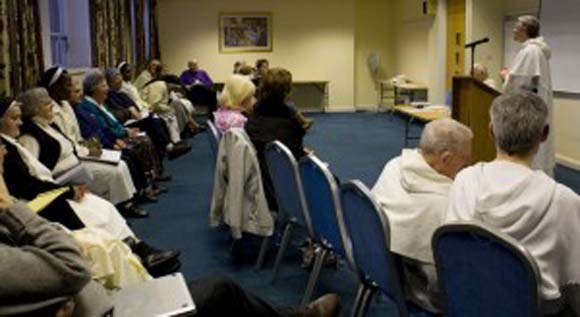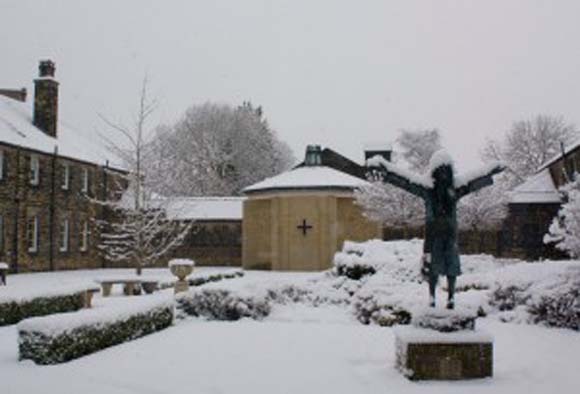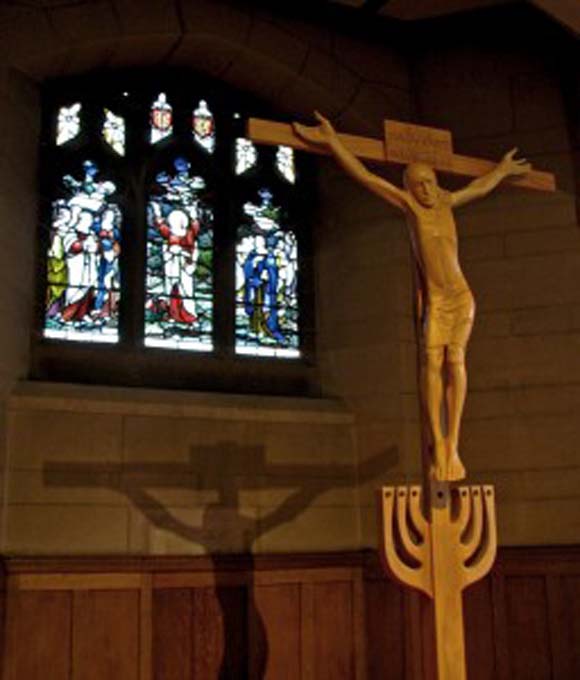
Dominican Seminar 2010 – The Prodigal Son
 This year’s Dominican Seminar in Leeds looked at the writing and theology of St Luke. In the opening session, we considered the parables of Luke’s gospel. Three parables were chosen for special consideration: Janet Wiltshire OP looked at the Good Samaritan and Patrick Doyle OP pondered the Parable of the Rich Fool. Below is the reflection offered by fr Lawrence Lew OP on the Parable of the Prodigal Son.
This year’s Dominican Seminar in Leeds looked at the writing and theology of St Luke. In the opening session, we considered the parables of Luke’s gospel. Three parables were chosen for special consideration: Janet Wiltshire OP looked at the Good Samaritan and Patrick Doyle OP pondered the Parable of the Rich Fool. Below is the reflection offered by fr Lawrence Lew OP on the Parable of the Prodigal Son.
“I’d like to offer some thoughts on what is often called the parable of the prodigal son. I think I can only hope to sketch some ideas that will barely scratch the surface of this well-loved parable, but what I wish to do is briefly to consider some elements of this parable within the context of a theology of grace, and particularly of repentance.
The parable is one of three in Luke 15, and they all have in common the notion of repentance, and in this parable we are presented with two sons: one who repents and the other who doesn’t. In the time available to me, I wish to concentrate on the repentant son and indeed on just verses 20-24. Within its context, then, the parable would seem to offer us some insight into how God deals with repentant sinners. I think it is important that the God we consider is always the Triune God, Father, Son and Holy Spirit. With this in mind, then, we avoid the easy identification of the father of the parable with just God the Father. Rather, the father of the parable stands for God – Father, Son and Holy Spirit.
Something that strikes me is that in the parable, the father sees the son from a great way off, and he runs out towards him and kisses him. There are two aspects here that I wish to look at: the going out of the father and the kiss. To speak of God as going out seems to me to suggest procession, and the kiss signifies love. So, as St Thomas says, that “what proceeds in God by way of love, does not proceed as begotten, or as Son, but proceeds rather as Spirit”. And elsewhere, in the Fathers of the Church, the Spirit has been referred to as the kiss of the Father and the Son. Hence, I wish to link the figure of the father in the parable to the Spirit.
This is not because the grace of repentance is limited to the activity of the Spirit alone. Indeed, the whole Trinity acts in the economy of salvation, but I think we can say that the work of repentance is appropriated to the Spirit, such that the Church can say that “the Father of mercies … has sent the Holy Spirit among us for the forgiveness of sins”. Moreover, I think this emphasis on the person of the Holy Spirit in the work of repentance and reconciliation fits in well with the general Lucan narrative because, as I am hopeful we will see in these days, Luke-Acts is suffused with the Holy Spirit and with people who act under the Spirit’s prompting and inspiration. So, by linking the father of this parable with the Spirit, I hope to tie this parable more closely with a key Lucan feature: his pneumatology.
 If I am permitted to make this kind of appropriation, then, let us proceed to consider what God does to the repentant sinner. First, note that the son in the parable says: “I am no longer worthy to be called your son”. And this is what happens when we fall into mortal sin, and so are cut off from the new life of divine sonship that is ours through our baptism into Jesus Christ; hence, the father in the parable says that the prodigal son was dead. In fact, we are never worthy of the grace of adoption as God’s children, which is why the prodigal son does not say, ‘I am no longer worthy to be your son’. No, he says, he is not worthy to be called his son. So too, the Christian who has sinned mortally after baptism cannot be worthy to be called daughter or son of God. And so repentance begins with a realization of the sorry state we are in, and how far we have put ourselves from the filial dignity to which we had been elevated by God’s grace. And we are moved to abhor sin and drawn to God’s goodness and mercy. Thus, the sinner moves by faith towards God, just as the son arose and went home.
If I am permitted to make this kind of appropriation, then, let us proceed to consider what God does to the repentant sinner. First, note that the son in the parable says: “I am no longer worthy to be called your son”. And this is what happens when we fall into mortal sin, and so are cut off from the new life of divine sonship that is ours through our baptism into Jesus Christ; hence, the father in the parable says that the prodigal son was dead. In fact, we are never worthy of the grace of adoption as God’s children, which is why the prodigal son does not say, ‘I am no longer worthy to be your son’. No, he says, he is not worthy to be called his son. So too, the Christian who has sinned mortally after baptism cannot be worthy to be called daughter or son of God. And so repentance begins with a realization of the sorry state we are in, and how far we have put ourselves from the filial dignity to which we had been elevated by God’s grace. And we are moved to abhor sin and drawn to God’s goodness and mercy. Thus, the sinner moves by faith towards God, just as the son arose and went home.
But the father does not wait for the son to come to him but has compassion and runs out to him. This reminds me of the divine initiative, for it is God and God alone who stirs up faith in us, and who gives us the grace of repentance and who justifies the repentant sinner. For only God can restore the dead to life, just as only God can create out of nothing. And God does all this because of his love for us, and because he has compassion for us poor sinners.
Then, God does three things to the repentant sinner. He gives him a robe, a ring, and sandals for his feet. These indicate a restoration of the dignity of sonship, of course. But more specifically, I would suggest that the robe can be seen as a reference to being clothed in justifying grace, the grace of Christ which renders us pleasing to God. As clothing, it also calls to mind the restoration of the baptismal garment which we are charged to keep pure and spotless until Christ returns in glory. It is this same white garment that is worn by those who follow the Lamb of Revelations in heaven. So, St Thomas says, this white garment is given as a sign of the glorious resurrection, unto which men are born again by Baptism; and in order to designate the purity of life, to which he will be bound after being baptized, according to Rm. 6:4: ‘That we may walk in newness of life’.
The ring, a signet ring perhaps, bears the impression and seal of the father. So too the grace of baptism and repentance restores us in the image of God, an image which had been disfigured by sin. Since grace transforms us and fashions us in the image of the Son of God, so too the ring is a sign of our restoration to filial dignity as daughters and sons of God.
Thirdly, the shoes, I would suggest are an evocation of friendship with God. For it is Moses who was told to take off his shoes for he stood on holy ground, and the unshod state is symbolic of slavery and servitude. However, since Christ has called us his friends, a friendship which is ours when we are elevated by grace, so we no longer have to be unshod as slaves but are given shoes so that we can, as it were, stand on the same ground with God.
 Finally, the father kills the fatted calf and feasts and makes merry with the prodigal son. The image of the banquet, which is given in honour of the sinner, is a sign of the Eucharistic feast. For in the Eucharist, all of us who are unworthy sinners, but who have been given the restorative grace of God through baptism and reconciliation, are called to rejoice and feast together. And this feast is itself a foretaste of the banquet of eternal life with God, which is the supernatural end of the life of grace. Does this mean that the fatted calf stands for Jesus Christ, who dies for our health and salvation, giving himself up so that we may make merry in the eternal feast of heaven? It does not require a terrible stretch of the imagination to move from calling him the Lamb of God, and of course, the calf would one day grow into an unblemished white heifer, which is precisely the Old Testament sacrifice offered to God, a sacrifice that is a prefigurement of the Cross.
Finally, the father kills the fatted calf and feasts and makes merry with the prodigal son. The image of the banquet, which is given in honour of the sinner, is a sign of the Eucharistic feast. For in the Eucharist, all of us who are unworthy sinners, but who have been given the restorative grace of God through baptism and reconciliation, are called to rejoice and feast together. And this feast is itself a foretaste of the banquet of eternal life with God, which is the supernatural end of the life of grace. Does this mean that the fatted calf stands for Jesus Christ, who dies for our health and salvation, giving himself up so that we may make merry in the eternal feast of heaven? It does not require a terrible stretch of the imagination to move from calling him the Lamb of God, and of course, the calf would one day grow into an unblemished white heifer, which is precisely the Old Testament sacrifice offered to God, a sacrifice that is a prefigurement of the Cross.
So, I think it would not be unreasonable to read the text in this way, and indeed to look at this parable through this theological lens. And I ought to end here before I go too far or take up too much of your time!”


